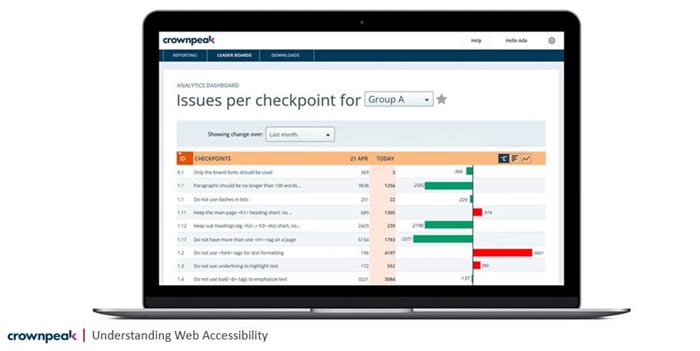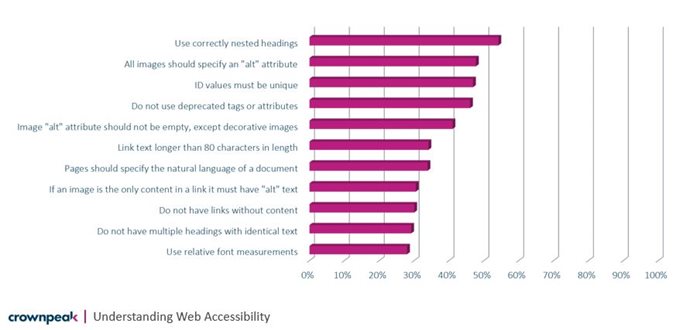Complying with Web Accessibility Laws & Best Practices
By Laura Myers
August 13, 2018
Brand Safety, Crownpeak, Digital Quality Management, Forrester, SEO, W3C, WCAG 2.0, Web Accessibility Initiative, Web Content Accessibility Guidelines, Web Content Management, Website Accessibility
Ensuring effective web accessibility can be a daunting task because the strategy, unfortunately, receives less attention that it deserves simply because it can be clouded with a notion of complexity when in reality, a deeper understanding of the benefits of an effective accessibility strategy can be a game changer. Thankfully, lately website compliance and accessibility best practices have been gaining momentum as a must-have in every organization’s digital strategy.
The difficulty comes from, I think, a misunderstanding of how user groups in need of accessibility are defined and this alone, takes the need from micro to macro pretty quickly but beyond that, and what should surpass this in prerogative, are the benefits for a business to be adept with their web accessibility.
This is a topic I am covering with Stewart Maurer, Vice President of Marketing at Crownpeak as he goes through some surprising details on how disabilities are defined, the benefits for a business to be intelligent with their accessibility and compliance and how an organization can best deploy their own accessibility strategy.
Defining Web Accessibility
At its most basic level, as Stewart explained: “web accessibility is about providing experiences on the web that are accessible for all audiences regardless of device or disability they may have.” He goes on to explain how Gartner relates it additionally to the value all visitors can get from your site, which perfectly positions the need for businesses to make their web experience accessible all inclusive, especially when you think of the value they are missing.
As Stewart helped me better understand web accessibility, him explaining the true definitions of what classifies the disabilities that web accessibility is intended to serve was eye-opening in not only the necessity for it but also in how a site should be accessible. He very concisely broke the definitions down into three categories all based around some sort of physical or cognitive impairment however, the variation of circumstance is what brings the entire concept down to earth.
He starts with permanent disability, which I would say is the more common group initially thought of, individuals who may have lost their sight, or their hearing, or even lost a portion of their mobility as examples. Next there would be temporary disability, which would include as Stewart mentions something with a broken arm, sprained wrist, or I would think some levels of visual or hearing impairment that are resolvable with eyewear or hearing aids a user might not have on hand at the moment. Finally, there is situational disability, the one that really can impact all of us at some point in time and shows how wide spread the need for web accessibility is. Stewart gives the great example of “think of it like you’re in bright sunlight looking at a screen, or if you’re a mom carrying a baby in one hand and groceries in the other hand and you’re still trying to thumb through your phone to find some information.”
The Business Value of Accessibility
Stewart brought up an insight here that I would guess might be the main reason why more businesses aren’t focusing more on web accessibility best practices, many view it as just risk-avoidance when in reality, there is tremendous business value to be gleaned from an intelligent accessibility and compliance strategy. Risk-avoidance isn’t without its own value however:
“Customers will come to us initially around risk-avoidance and with good reason. There is increasing litigation around accessibility related issues, the fines can be quite steep, the remediation costs can be expensive and you can suffer from brand damage, if you don’t do it and you’re subject to one of those lawsuits.

We try to encourage people to think about the more positive aspects like where the business benefits, the revenue benefits. There was a recent piece of research published by Gina Bhawalkar at Forrester that is called ‘The Billion Customer Opportunity’ and in it what she is really getting at is there are over a billion people in the world suffering from some sort of disability. They have a combined spending power of over a trillion dollars. I think that’s an underserved market that businesses tend not to prioritize, and it can also be quite a loyal market and one that is looking for brands that cater to disabilities. There is a ton of revenue potential in accessibility when it’s a priority for organizations.
The third thing is it just benefits the brand. You’re starting to see companies like Microsoft and Apple make accessibility part of their product but also really bake it in their company culture and that can have a benefit in terms of generating employee good-will, helps with recruiting and has a business benefit in that it shows they’re looking to do business with people who are doing the right thing.”
Web Accessibility and SEO
In discussing business value, I inquired with Stewart on the value of accessibility when it comes to SEO. Search engine optimization can be such a heavy focus for some, and it can feel like bit of a game of wits more often than not in keeping up with current SEO trend and weaving the strategy into your content and website, the more inconspicuously the better. He replied:
“Often, we think of the two things as being completely separate but the reality is, the same principles that make an accessible website, be it the ones that also make it discoverable, and a website that is optimized for search. You and I, we look at website together, it’s pretty easy to understand what to do, we can get the navigation, we can read the copy on the page, we can see the images that are there and probably know what we’re going to go do next. But when you consider someone using that same webpage using a screen reading device or how Google or another search engine scans that, they’re not looking at the visual things, they’re looking at the underlying metadata and html.
Everything you and I might see has to be done properly in that markup code so in making an accessible website, you’re also making one that Google and other search engines can easily index, easily crawl, easily make sense of. I always like to ask the question when I’m talking about accessibility, do you have a blind visitor on your website? Half the time I won’t get any hands up, the reality is we all do, its Google and other search engines, they’re not different.”
How to Make your Website Accessible
Thankfully, there are clear-cut guidelines that give a great roadmap to accessibility. Stewart notes the W3C has ‘taken the lead’ with their creation of the Web Content Accessibility Guidelines or WCAG and it is more commonly known. He describes them as the ‘de facto guidelines’ organizations use around the world to determine their own website accessibility best practices. They have been around since 1999, and through a few updates since then they remain broken out into dozens of guidelines, but Stewart points out a few key things to always know.
There are three levels, A, AA, AAA with each getting more stringent in terms of the guidelines businesses need to meet and while he emphasizes there is no right level for an organization but at Crownpeak they often see some of the biggest brands going for AA compliance. Even though there are a number of guidelines as he mentioned, there are four key principles he advises businesses remember and he uses the acronym of POUR as a way to keep them top of mind:
Perceivable: “visitors have to be able to perceive information that is being presented to them, it can’t be invisible to all of their senses.”
Operable: “they need to be able to come to that website and navigate through it, operate the website regardless of the device, disability or assistive technology that they’re using.”
Understandable: “the information and operation of the website has to be reasonably understandable for that audience.”
Robust: “the content has to be robust enough to accommodate any assistive technology or user agents that are used or might be used when visitors are coming to the website.”
Ending Notes
What was most interesting, is when Stewart explained Crownpeak recently did a study of the Fortune 500 with the goal of understanding how the companies with the biggest financial resources to address accessibility and the biggest reputation on the line to get it right. To see how they all did they put them through their digital quality management tool, and found across the Fortune 500 companies they saw an average of six errors on every single website tested.

By resources of course he meant the large digital teams of developers and editors all supporting the web presence of these huge brands that by their sheer size, serve expansive audiences. What I loved, and maybe this is my competitive nature showing through, was how he pointed to this as a way for businesses who aren’t in the Fortune 500 to see their own advantage in that shortfall by their larger competitors to make a concerted effort to outshine in respect to web accessibility for their own business.
The even better thing was that during out interview, he even listed the main things these Fortune 500 brands were missing or doing wrong that were not only pretty important to the combination of good web accessibility lending to even better SEO but also really easy to address and fix for businesses who don’t have the large amount of resources these big brands do.
The overall message however is clear, website accessibility can be seen as scary by some but a walk in and around the concepts of why it’s important and how business stand to not only benefit but get a leg up on competitors should be reason enough to establish and deploy your best of accessibility and compliance practices.

Laura Myers
A digital business, marketing and social media enthusiast, Laura thrives on asking unique, insightful questions to ignite conversation. At an event or remotely, she enjoys any opportunity to connect with like-minded people in the industry.